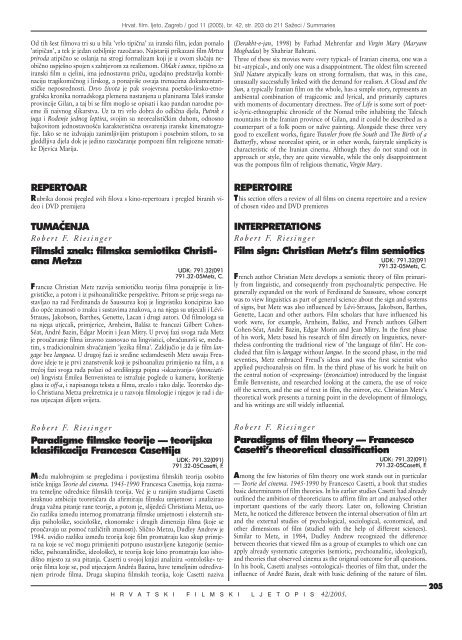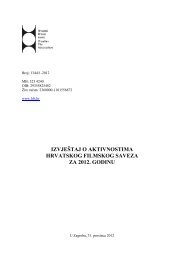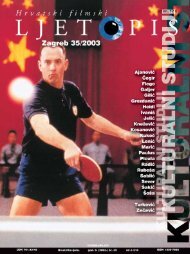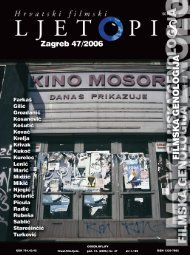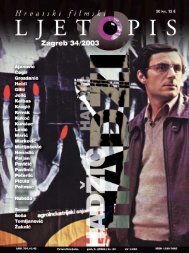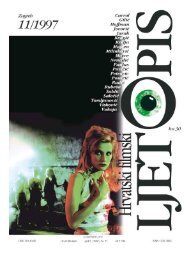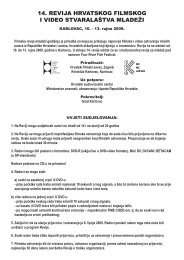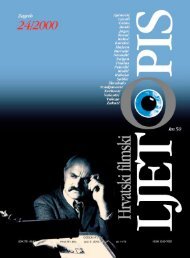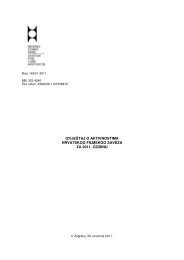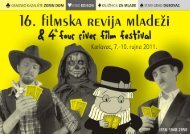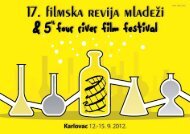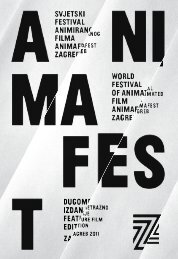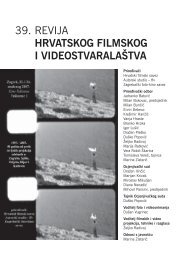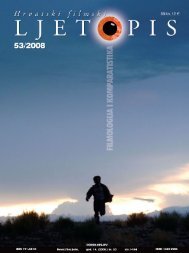Create successful ePaper yourself
Turn your PDF publications into a flip-book with our unique Google optimized e-Paper software.
Hrvat. film. ljeto, Zagreb / god 11 (2005), br. 42, str. 203 do 211 Sa`eci / Summaries<br />
Od tih {est filmova tri su u bila ’vrlo tipi~na’ za iranski film, jedan pomalo<br />
’atipi~an’, a tek je jedan ozbiljnije razo~arao. Najstariji prikazani film Mrtva<br />
priroda atipi~no se oslanja na strogi formalizam koji je u ovom slu~aju neobi~no<br />
uspje{no spojen s zahtjevom za realizmom. Oblak i sunce, tipi~no za<br />
iranski film u cjelini, ima jednostavnu pri~u, ugo|ajno predstavlja kombinaciju<br />
tragikomi~nog i lirskog, a ponajvi{e osvaja trenucima dokumentaristi~ke<br />
neposrednosti. Drvo `ivota je pak svojevrsna poetsko-lirsko-etnografska<br />
kronika nomadskoga plemena nastanjena u planinama Tale{ iranske<br />
provincije Gilan, a taj bi se film moglo se opisati i kao pandan narodne poeme<br />
ili naivnog slikarstva. Uz ta tri vrlo dobra do odli~na djela, Putnik s<br />
juga i Ro|enje jednog leptira, svojim su neorealisti~kim duhom, odnosno<br />
bajkovitom jednostavno{}u karakteristi~na osvarenja iranske kinematografije.<br />
Iako se ne izdvajaju zanimljivijim pristupom i posebnim stilom, to su<br />
gleddljiva djela dok je jedino razo~aranje pompozni film religiozne tematike<br />
Djevica Marija.<br />
REPERTOAR<br />
Rubrika donosi pregled svih filova s kino-repertoara i pregled biranih video<br />
i DVD premijera<br />
TUMA^ENJA<br />
Robert F. Riesinger<br />
Filmski znak: filmska semiotika Christiana<br />
Metza<br />
UDK: 791.32(091<br />
791.32-05Metz, C.<br />
Francuz Christian Metz razvija semioti~ku teoriju filma ponajprije iz lingvisti~ke,<br />
a potom i iz psihoanaliti~ke perspektive. Pritom se prije svega nastavljao<br />
na rad Ferdinanda de Saussurea koji je lingvistiku koncipirao kao<br />
dio op}e znanosti o znaku i sustavima znakova, a na njega su utjecali i Lévi-<br />
Strauss, Jakobson, Barthes, Genette, Lacan i drugi autori. Od filmologa su<br />
na njega utjecali, primjerice, Arnheim, Balász te francuzi Gilbert Cohen-<br />
Séat, André Bazin, Edgar Morin i Jean Mitry. U prvoj fazi svoga rada Metz<br />
je prou~avanje filma izravno zasnovao na lingvistici, obra~unav{i se, me|utim,<br />
s tradicionalnim shva}anjem ’jezika filma’. Zaklju~io je da je film langage<br />
bez languea. U drugoj fazi iz sredine sedamdesetih Metz usvaja Freudove<br />
ideje te je prvi znanstvenik koji je psihoanalizu primijenio na film, a u<br />
tre}oj fazi svoga rada polazi od sredi{njega pojma »iskazivanja« (énonciation)<br />
lingvista Émilea Benvenistea te istra`uje poglede u kameru, kori{tenje<br />
glasa iz off-a, i napisanoga teksta u filmu, zrcalo i tako dalje. Teoretsko djelo<br />
Christiana Metza prekretnica je u razvoju filmologije i njegov je rad i danas<br />
utjecajan diljem svijeta.<br />
Robert F. Riesinger<br />
Paradigme filmske teorije — teorijska<br />
klasifikacija Francesca Casettija<br />
UDK: 791.32(091)<br />
791.32-05Casetti, F.<br />
Me|u malobrojnim se pregledima i povijestima <strong>filmski</strong>h teorija osobito<br />
isti~e knjiga Teorie del cinema. 1945-1990 Francesca Casettija, koja razmatra<br />
temeljne odrednice <strong>filmski</strong>h teorija. Ve} je u ranijim studijama Casetti<br />
istaknuo ambiciju teoreti~ara da afirmiraju filmsku umjetnost i analizirao<br />
druga va`na pitanje rane teorije, a potom je, slijede}i Christiana Metza, uo-<br />
~io razliku izme|u internog promatranja filmske umjetnosti i eksternih studija<br />
psiholo{ke, sociolo{ke, ekonomske i drugih dimenzija filma (koje se<br />
prou~avaju uz pomo} razli~itih znanosti). Sli~no Metzu, Dudley Andrew je<br />
1984. uvidio razliku izme|u teorija koje film promatraju kao skup primjera<br />
na koje se ve} mogu primijeniti potpuno usustavljene kategorije (semioti~ke,<br />
psihoanaliti~ke, ideolo{ke), te teorija koje kino promatraju kao ishodi{no<br />
mjesto za sva pitanja. Casetti u svojoj knjizi analizira »ontolo{ke« teorije<br />
filma koje se, pod utjecajem Andréa Bazina, bave temeljnim odre|ivanjem<br />
prirode filma. Druga skupina <strong>filmski</strong>h teorija, koje Casetti naziva<br />
(Derakht-e-jan, 1998) by Farhad Mehrenfar and Virgin Mary (Maryam<br />
Moghadas) by Shahriar Bahrani.<br />
Three of these six movies were »very typical« of Iranian cinema, one was a<br />
bit »atypical«, and only one was a disappointment. The oldest film screened<br />
Still Nature atypically leans on strong formalism, that was, in this case,<br />
unusually successfully linked with the demand for realism. A Cloud and the<br />
Sun, a typically Iranian film on the whole, has a simple story, represents an<br />
ambiental combination of tragicomic and lyrical, and primarily captures<br />
with moments of documentary directness. Tree of Life is some sort of poetic-lyric-ethnographic<br />
chronicle of the Nomad tribe inhabiting the Talesch<br />
mountains in the Iranian province of Gilan, and it could be described as a<br />
counterpart of a folk poem or naïve painting. Alongside these three very<br />
good to excellent works, figure Traveler from the South and The Birth of a<br />
Butterfly, whose neorealist spirit, or in other words, fairytale simplicity is<br />
characteristic of the Iranian cinema. Although they do not stand out in<br />
approach or style, they are quite viewable, while the only disappointment<br />
was the pompous film of religious thematic, Virgin Mary.<br />
REPERTOIRE<br />
This section offers a review of all films on cinema repertoire and a review<br />
of chosen video and DVD premieres<br />
INTERPRETATIONS<br />
Robert F. Riesinger<br />
Film sign: Christian Metz’s film semiotics<br />
UDK: 791.32(091<br />
791.32-05Metz, C.<br />
French author Christian Metz develops a semiotic theory of film primarily<br />
from linguistic, and consequently from psychoanalytic perspective. He<br />
generally expanded on the work of Ferdinand de Saussure, whose concept<br />
was to view linguistics as part of general science about the sign and systems<br />
of signs, but Metz was also influenced by Lévi-Strauss, Jakobson, Barthes,<br />
Genette, Lacan and other authors. Film scholars that have influenced his<br />
work were, for example, Arnheim, Balász, and French authors Gilbert<br />
Cohen-Séat, André Bazin, Edgar Morin and Jean Mitry. In the first phase<br />
of his work, Metz based his research of film directly on linguistics, nevertheless<br />
confronting the traditional view of ’the language of film’. He concluded<br />
that film is langage without langue. In the second phase, in the mid<br />
seventies, Metz embraced Freud’s ideas and was the first scientist who<br />
applied psychoanalysis on film. In the third phase of his work he built on<br />
the central notion of »expressing« (énonciation) introduced by the linguist<br />
Émile Benveniste, and researched looking at the camera, the use of voice<br />
off the screen, and the use of text in film, the mirror, etc. Christian Metz’s<br />
theoretical work presents a turning point in the development of filmology,<br />
and his writings are still widely influential.<br />
Robert F. Riesinger<br />
Paradigms of film theory — Francesco<br />
Casetti’s theoretical classification<br />
UDK: 791.32(091)<br />
791.32-05Casetti, F.<br />
Among the few histories of film theory one work stands out in particular<br />
— Teorie del cinema. 1945-1990 by Francesco Casetti, a book that studies<br />
basic determinants of film theories. In his earlier studies Casetti had already<br />
outlined the ambition of theoreticians to affirm film art and analysed other<br />
important questions of the early theory. Later on, following Christian<br />
Metz, he noticed the difference between the internal observation of film art<br />
and the external studies of psychological, sociological, economical, and<br />
other dimensions of film (studied with the help of different sciences).<br />
Similar to Metz, in 1984, Dudley Andrew recognized the difference<br />
between theories that viewed film as a group of examples to which one can<br />
apply already systematic categories (semiotic, psychoanalitic, ideological),<br />
and theories that observed cinema as the original outcome for all questions.<br />
In his book, Casetti analyses »ontological« theories of film that, under the<br />
influence of André Bazin, dealt with basic defining of the nature of film.<br />
205<br />
H R V A T S K I F I L M S K I L J E T O P I S 42/2005.


